Health and Socio-Political Issues in Aged Care
VerifiedAdded on 2023/06/11
|15
|4772
|212
AI Summary
This article discusses the health and socio-political issues in aged care in Australia. It explains the Consumer Directed Care (CDC) model and its advantages and disadvantages. The article also covers the political, ethical, and legal views of aged care and the issues associated with the CDC model.
Contribute Materials
Your contribution can guide someone’s learning journey. Share your
documents today.
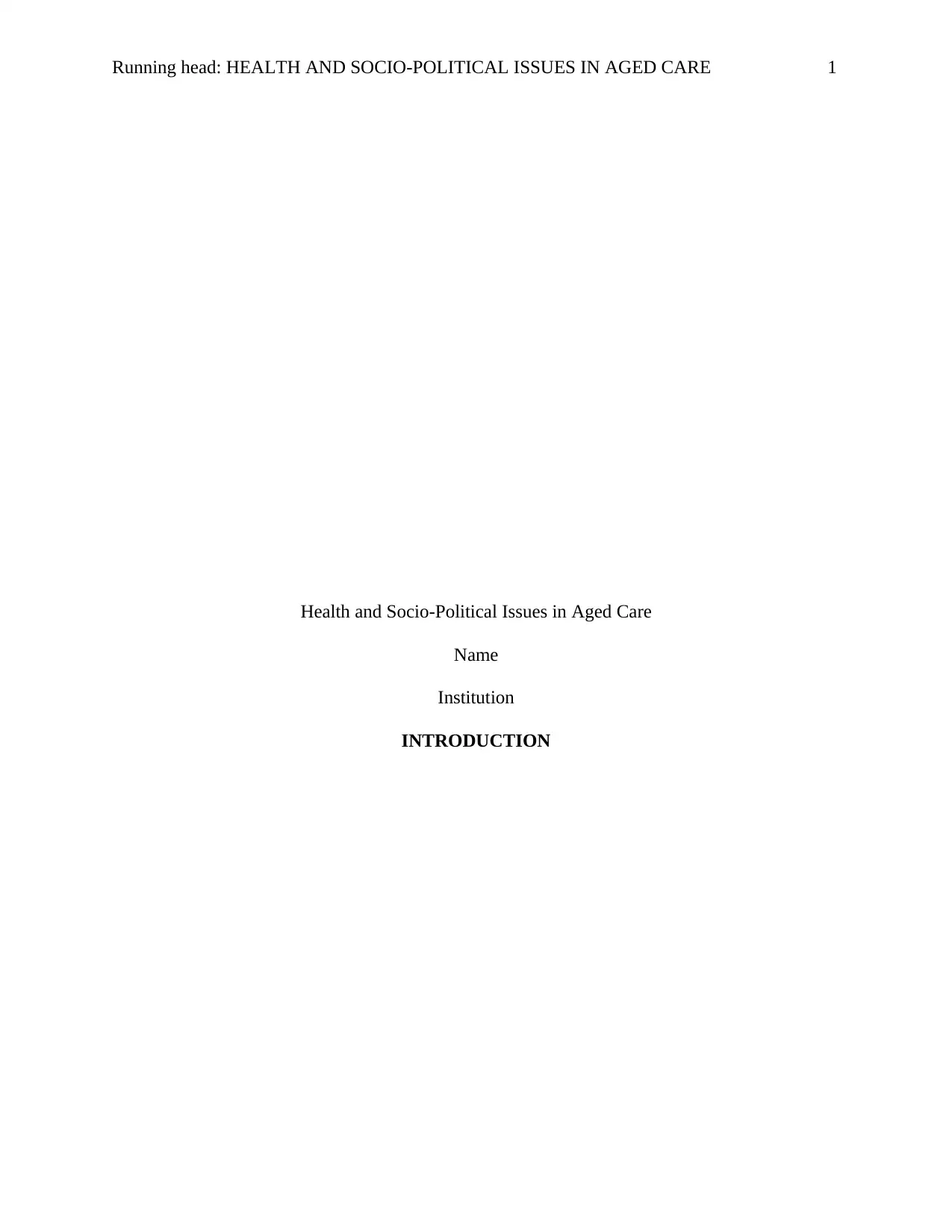
Running head: HEALTH AND SOCIO-POLITICAL ISSUES IN AGED CARE 1
Health and Socio-Political Issues in Aged Care
Name
Institution
INTRODUCTION
Health and Socio-Political Issues in Aged Care
Name
Institution
INTRODUCTION
Secure Best Marks with AI Grader
Need help grading? Try our AI Grader for instant feedback on your assignments.
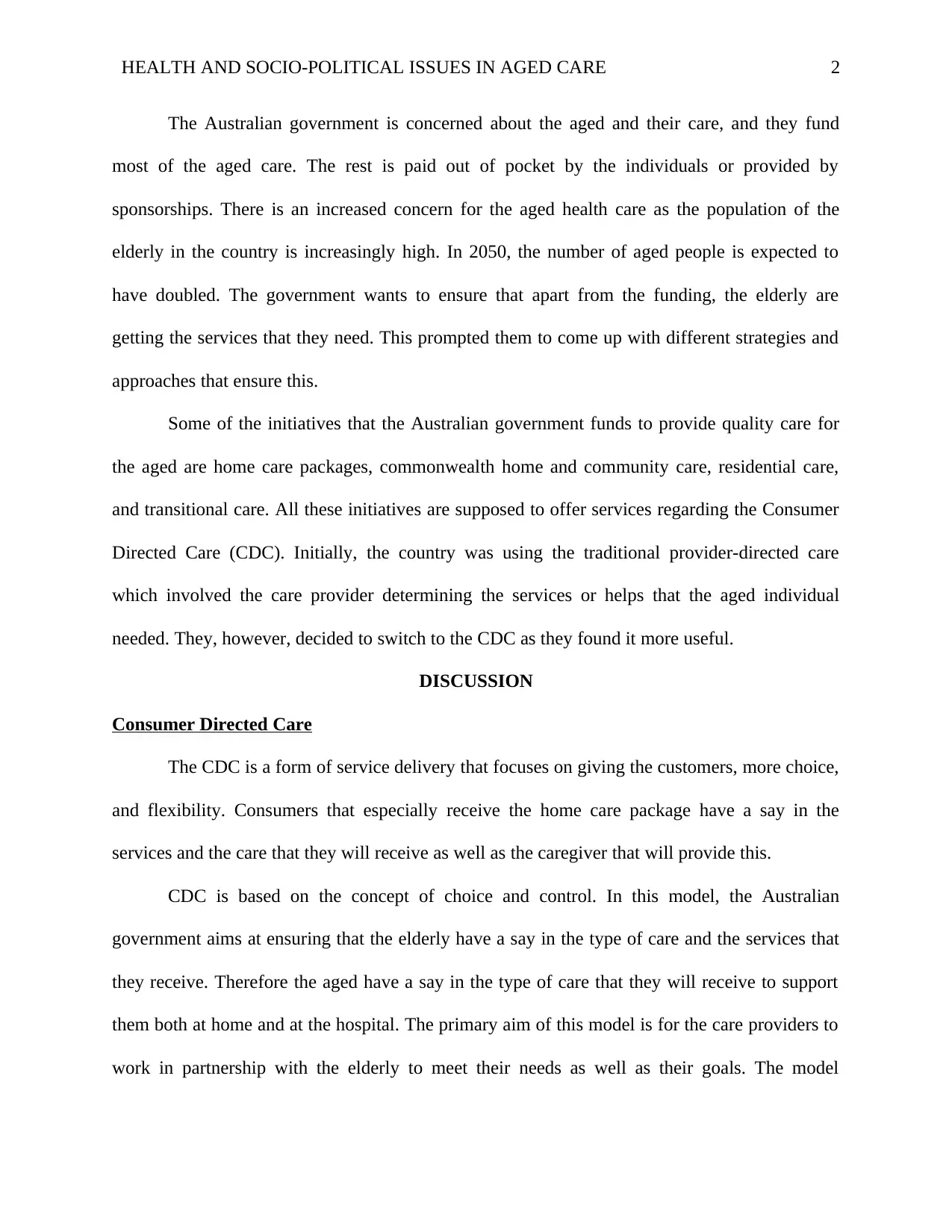
HEALTH AND SOCIO-POLITICAL ISSUES IN AGED CARE 2
The Australian government is concerned about the aged and their care, and they fund
most of the aged care. The rest is paid out of pocket by the individuals or provided by
sponsorships. There is an increased concern for the aged health care as the population of the
elderly in the country is increasingly high. In 2050, the number of aged people is expected to
have doubled. The government wants to ensure that apart from the funding, the elderly are
getting the services that they need. This prompted them to come up with different strategies and
approaches that ensure this.
Some of the initiatives that the Australian government funds to provide quality care for
the aged are home care packages, commonwealth home and community care, residential care,
and transitional care. All these initiatives are supposed to offer services regarding the Consumer
Directed Care (CDC). Initially, the country was using the traditional provider-directed care
which involved the care provider determining the services or helps that the aged individual
needed. They, however, decided to switch to the CDC as they found it more useful.
DISCUSSION
Consumer Directed Care
The CDC is a form of service delivery that focuses on giving the customers, more choice,
and flexibility. Consumers that especially receive the home care package have a say in the
services and the care that they will receive as well as the caregiver that will provide this.
CDC is based on the concept of choice and control. In this model, the Australian
government aims at ensuring that the elderly have a say in the type of care and the services that
they receive. Therefore the aged have a say in the type of care that they will receive to support
them both at home and at the hospital. The primary aim of this model is for the care providers to
work in partnership with the elderly to meet their needs as well as their goals. The model
The Australian government is concerned about the aged and their care, and they fund
most of the aged care. The rest is paid out of pocket by the individuals or provided by
sponsorships. There is an increased concern for the aged health care as the population of the
elderly in the country is increasingly high. In 2050, the number of aged people is expected to
have doubled. The government wants to ensure that apart from the funding, the elderly are
getting the services that they need. This prompted them to come up with different strategies and
approaches that ensure this.
Some of the initiatives that the Australian government funds to provide quality care for
the aged are home care packages, commonwealth home and community care, residential care,
and transitional care. All these initiatives are supposed to offer services regarding the Consumer
Directed Care (CDC). Initially, the country was using the traditional provider-directed care
which involved the care provider determining the services or helps that the aged individual
needed. They, however, decided to switch to the CDC as they found it more useful.
DISCUSSION
Consumer Directed Care
The CDC is a form of service delivery that focuses on giving the customers, more choice,
and flexibility. Consumers that especially receive the home care package have a say in the
services and the care that they will receive as well as the caregiver that will provide this.
CDC is based on the concept of choice and control. In this model, the Australian
government aims at ensuring that the elderly have a say in the type of care and the services that
they receive. Therefore the aged have a say in the type of care that they will receive to support
them both at home and at the hospital. The primary aim of this model is for the care providers to
work in partnership with the elderly to meet their needs as well as their goals. The model
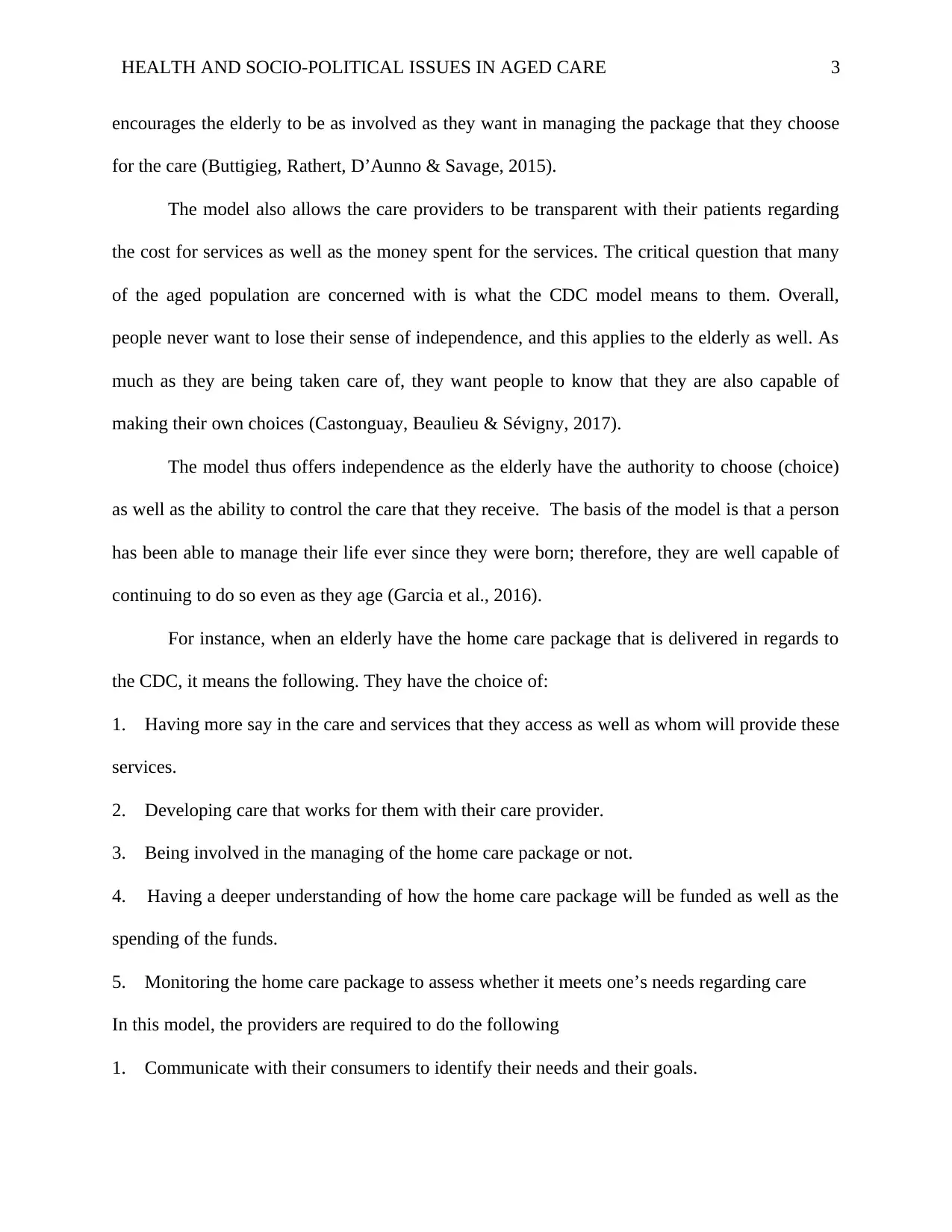
HEALTH AND SOCIO-POLITICAL ISSUES IN AGED CARE 3
encourages the elderly to be as involved as they want in managing the package that they choose
for the care (Buttigieg, Rathert, D’Aunno & Savage, 2015).
The model also allows the care providers to be transparent with their patients regarding
the cost for services as well as the money spent for the services. The critical question that many
of the aged population are concerned with is what the CDC model means to them. Overall,
people never want to lose their sense of independence, and this applies to the elderly as well. As
much as they are being taken care of, they want people to know that they are also capable of
making their own choices (Castonguay, Beaulieu & Sévigny, 2017).
The model thus offers independence as the elderly have the authority to choose (choice)
as well as the ability to control the care that they receive. The basis of the model is that a person
has been able to manage their life ever since they were born; therefore, they are well capable of
continuing to do so even as they age (Garcia et al., 2016).
For instance, when an elderly have the home care package that is delivered in regards to
the CDC, it means the following. They have the choice of:
1. Having more say in the care and services that they access as well as whom will provide these
services.
2. Developing care that works for them with their care provider.
3. Being involved in the managing of the home care package or not.
4. Having a deeper understanding of how the home care package will be funded as well as the
spending of the funds.
5. Monitoring the home care package to assess whether it meets one’s needs regarding care
In this model, the providers are required to do the following
1. Communicate with their consumers to identify their needs and their goals.
encourages the elderly to be as involved as they want in managing the package that they choose
for the care (Buttigieg, Rathert, D’Aunno & Savage, 2015).
The model also allows the care providers to be transparent with their patients regarding
the cost for services as well as the money spent for the services. The critical question that many
of the aged population are concerned with is what the CDC model means to them. Overall,
people never want to lose their sense of independence, and this applies to the elderly as well. As
much as they are being taken care of, they want people to know that they are also capable of
making their own choices (Castonguay, Beaulieu & Sévigny, 2017).
The model thus offers independence as the elderly have the authority to choose (choice)
as well as the ability to control the care that they receive. The basis of the model is that a person
has been able to manage their life ever since they were born; therefore, they are well capable of
continuing to do so even as they age (Garcia et al., 2016).
For instance, when an elderly have the home care package that is delivered in regards to
the CDC, it means the following. They have the choice of:
1. Having more say in the care and services that they access as well as whom will provide these
services.
2. Developing care that works for them with their care provider.
3. Being involved in the managing of the home care package or not.
4. Having a deeper understanding of how the home care package will be funded as well as the
spending of the funds.
5. Monitoring the home care package to assess whether it meets one’s needs regarding care
In this model, the providers are required to do the following
1. Communicate with their consumers to identify their needs and their goals.
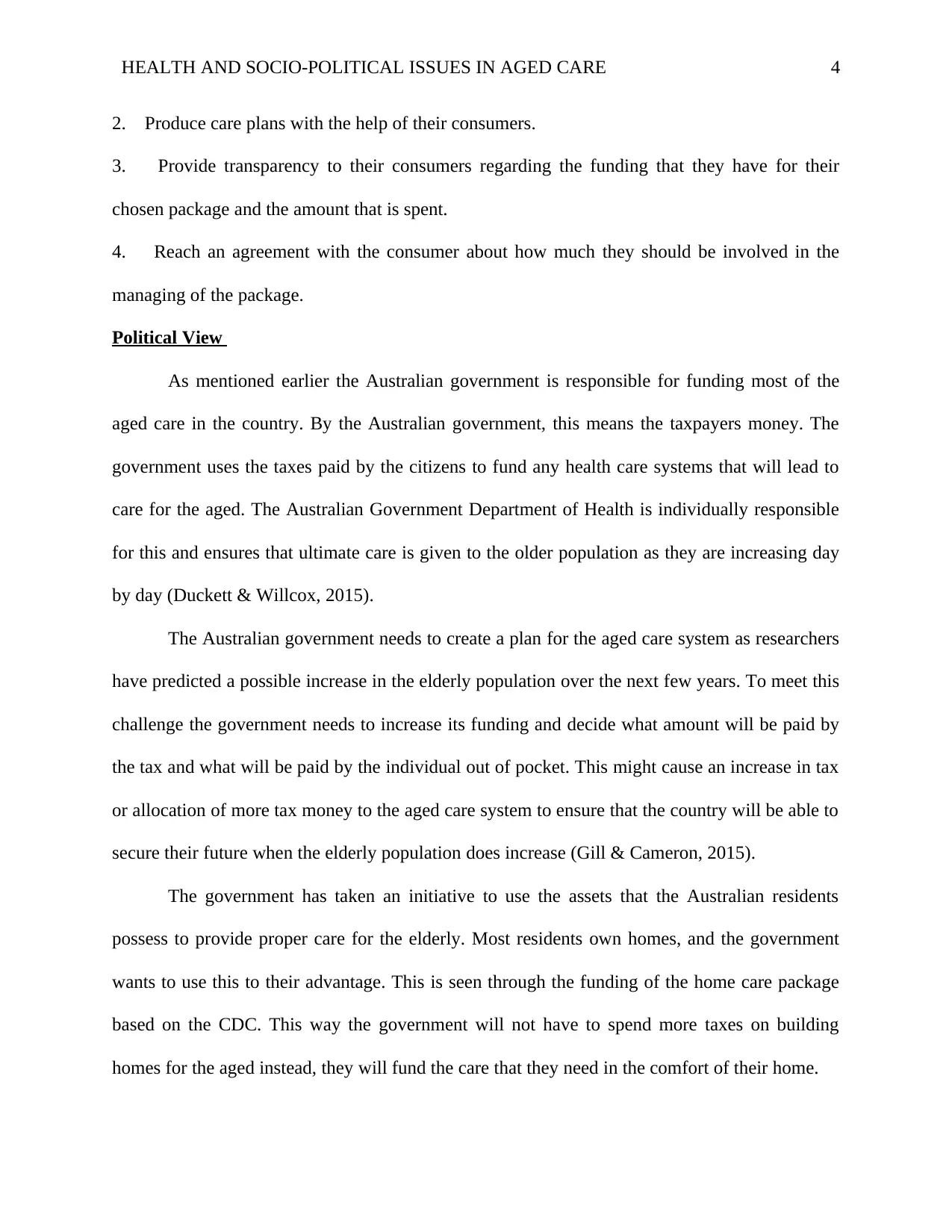
HEALTH AND SOCIO-POLITICAL ISSUES IN AGED CARE 4
2. Produce care plans with the help of their consumers.
3. Provide transparency to their consumers regarding the funding that they have for their
chosen package and the amount that is spent.
4. Reach an agreement with the consumer about how much they should be involved in the
managing of the package.
Political View
As mentioned earlier the Australian government is responsible for funding most of the
aged care in the country. By the Australian government, this means the taxpayers money. The
government uses the taxes paid by the citizens to fund any health care systems that will lead to
care for the aged. The Australian Government Department of Health is individually responsible
for this and ensures that ultimate care is given to the older population as they are increasing day
by day (Duckett & Willcox, 2015).
The Australian government needs to create a plan for the aged care system as researchers
have predicted a possible increase in the elderly population over the next few years. To meet this
challenge the government needs to increase its funding and decide what amount will be paid by
the tax and what will be paid by the individual out of pocket. This might cause an increase in tax
or allocation of more tax money to the aged care system to ensure that the country will be able to
secure their future when the elderly population does increase (Gill & Cameron, 2015).
The government has taken an initiative to use the assets that the Australian residents
possess to provide proper care for the elderly. Most residents own homes, and the government
wants to use this to their advantage. This is seen through the funding of the home care package
based on the CDC. This way the government will not have to spend more taxes on building
homes for the aged instead, they will fund the care that they need in the comfort of their home.
2. Produce care plans with the help of their consumers.
3. Provide transparency to their consumers regarding the funding that they have for their
chosen package and the amount that is spent.
4. Reach an agreement with the consumer about how much they should be involved in the
managing of the package.
Political View
As mentioned earlier the Australian government is responsible for funding most of the
aged care in the country. By the Australian government, this means the taxpayers money. The
government uses the taxes paid by the citizens to fund any health care systems that will lead to
care for the aged. The Australian Government Department of Health is individually responsible
for this and ensures that ultimate care is given to the older population as they are increasing day
by day (Duckett & Willcox, 2015).
The Australian government needs to create a plan for the aged care system as researchers
have predicted a possible increase in the elderly population over the next few years. To meet this
challenge the government needs to increase its funding and decide what amount will be paid by
the tax and what will be paid by the individual out of pocket. This might cause an increase in tax
or allocation of more tax money to the aged care system to ensure that the country will be able to
secure their future when the elderly population does increase (Gill & Cameron, 2015).
The government has taken an initiative to use the assets that the Australian residents
possess to provide proper care for the elderly. Most residents own homes, and the government
wants to use this to their advantage. This is seen through the funding of the home care package
based on the CDC. This way the government will not have to spend more taxes on building
homes for the aged instead, they will fund the care that they need in the comfort of their home.
Secure Best Marks with AI Grader
Need help grading? Try our AI Grader for instant feedback on your assignments.
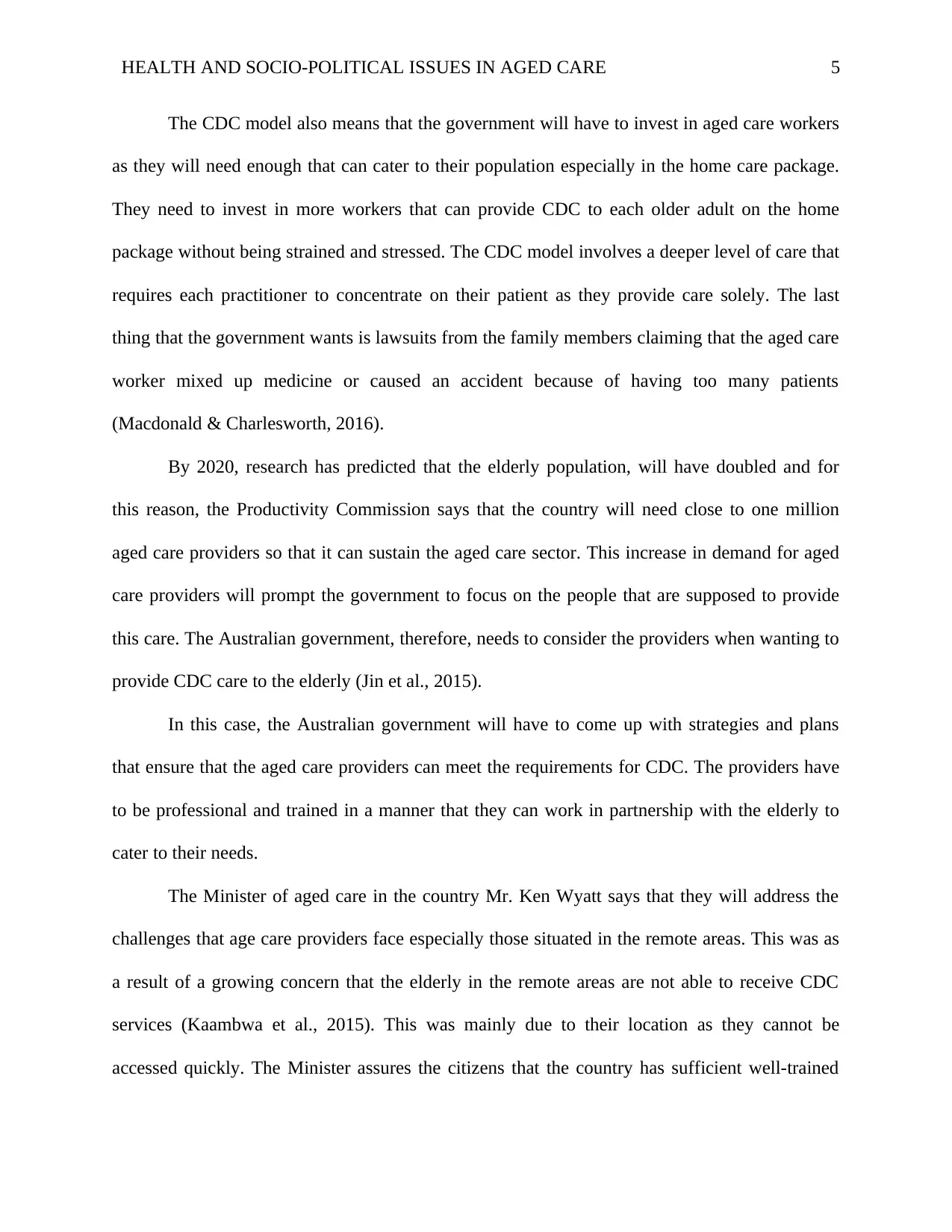
HEALTH AND SOCIO-POLITICAL ISSUES IN AGED CARE 5
The CDC model also means that the government will have to invest in aged care workers
as they will need enough that can cater to their population especially in the home care package.
They need to invest in more workers that can provide CDC to each older adult on the home
package without being strained and stressed. The CDC model involves a deeper level of care that
requires each practitioner to concentrate on their patient as they provide care solely. The last
thing that the government wants is lawsuits from the family members claiming that the aged care
worker mixed up medicine or caused an accident because of having too many patients
(Macdonald & Charlesworth, 2016).
By 2020, research has predicted that the elderly population, will have doubled and for
this reason, the Productivity Commission says that the country will need close to one million
aged care providers so that it can sustain the aged care sector. This increase in demand for aged
care providers will prompt the government to focus on the people that are supposed to provide
this care. The Australian government, therefore, needs to consider the providers when wanting to
provide CDC care to the elderly (Jin et al., 2015).
In this case, the Australian government will have to come up with strategies and plans
that ensure that the aged care providers can meet the requirements for CDC. The providers have
to be professional and trained in a manner that they can work in partnership with the elderly to
cater to their needs.
The Minister of aged care in the country Mr. Ken Wyatt says that they will address the
challenges that age care providers face especially those situated in the remote areas. This was as
a result of a growing concern that the elderly in the remote areas are not able to receive CDC
services (Kaambwa et al., 2015). This was mainly due to their location as they cannot be
accessed quickly. The Minister assures the citizens that the country has sufficient well-trained
The CDC model also means that the government will have to invest in aged care workers
as they will need enough that can cater to their population especially in the home care package.
They need to invest in more workers that can provide CDC to each older adult on the home
package without being strained and stressed. The CDC model involves a deeper level of care that
requires each practitioner to concentrate on their patient as they provide care solely. The last
thing that the government wants is lawsuits from the family members claiming that the aged care
worker mixed up medicine or caused an accident because of having too many patients
(Macdonald & Charlesworth, 2016).
By 2020, research has predicted that the elderly population, will have doubled and for
this reason, the Productivity Commission says that the country will need close to one million
aged care providers so that it can sustain the aged care sector. This increase in demand for aged
care providers will prompt the government to focus on the people that are supposed to provide
this care. The Australian government, therefore, needs to consider the providers when wanting to
provide CDC care to the elderly (Jin et al., 2015).
In this case, the Australian government will have to come up with strategies and plans
that ensure that the aged care providers can meet the requirements for CDC. The providers have
to be professional and trained in a manner that they can work in partnership with the elderly to
cater to their needs.
The Minister of aged care in the country Mr. Ken Wyatt says that they will address the
challenges that age care providers face especially those situated in the remote areas. This was as
a result of a growing concern that the elderly in the remote areas are not able to receive CDC
services (Kaambwa et al., 2015). This was mainly due to their location as they cannot be
accessed quickly. The Minister assures the citizens that the country has sufficient well-trained
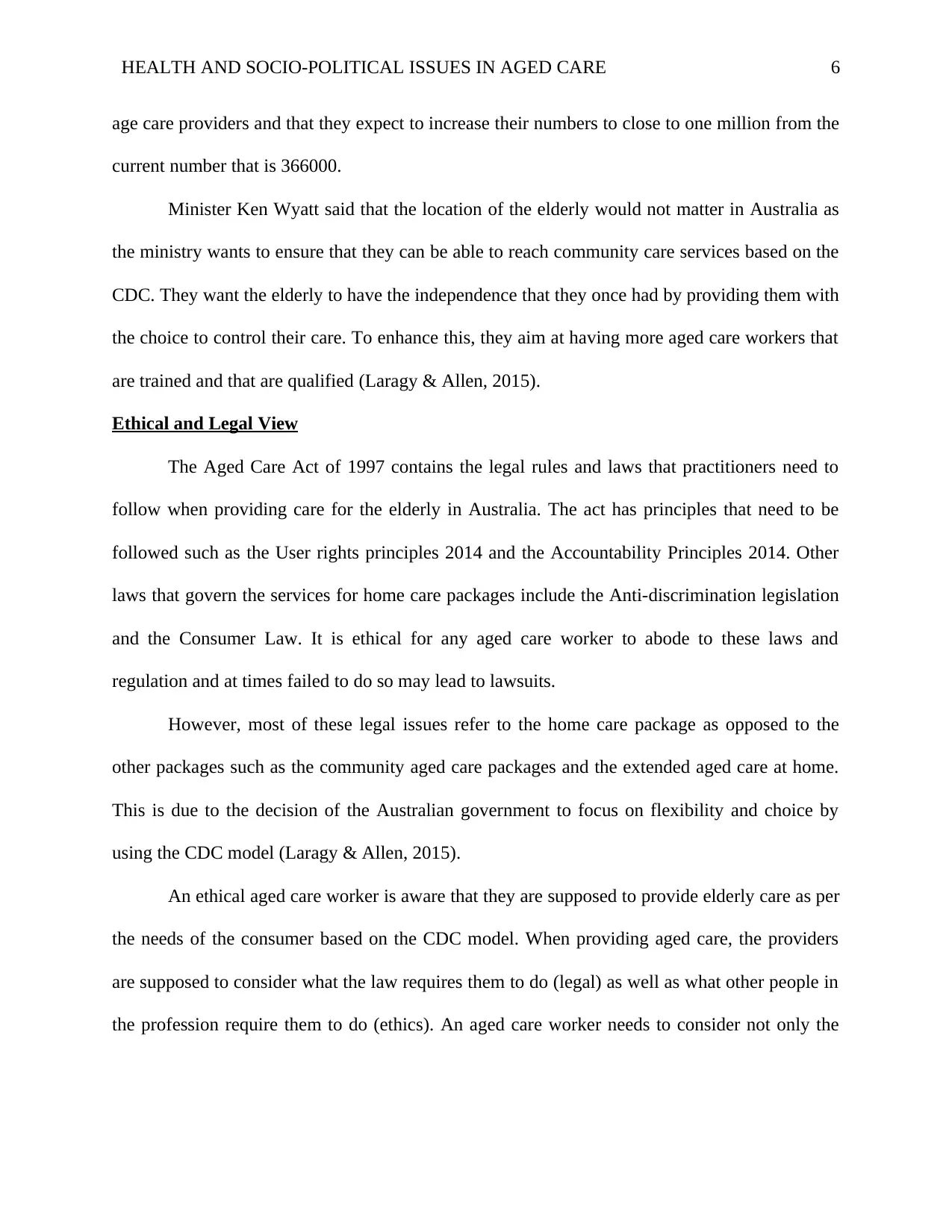
HEALTH AND SOCIO-POLITICAL ISSUES IN AGED CARE 6
age care providers and that they expect to increase their numbers to close to one million from the
current number that is 366000.
Minister Ken Wyatt said that the location of the elderly would not matter in Australia as
the ministry wants to ensure that they can be able to reach community care services based on the
CDC. They want the elderly to have the independence that they once had by providing them with
the choice to control their care. To enhance this, they aim at having more aged care workers that
are trained and that are qualified (Laragy & Allen, 2015).
Ethical and Legal View
The Aged Care Act of 1997 contains the legal rules and laws that practitioners need to
follow when providing care for the elderly in Australia. The act has principles that need to be
followed such as the User rights principles 2014 and the Accountability Principles 2014. Other
laws that govern the services for home care packages include the Anti-discrimination legislation
and the Consumer Law. It is ethical for any aged care worker to abode to these laws and
regulation and at times failed to do so may lead to lawsuits.
However, most of these legal issues refer to the home care package as opposed to the
other packages such as the community aged care packages and the extended aged care at home.
This is due to the decision of the Australian government to focus on flexibility and choice by
using the CDC model (Laragy & Allen, 2015).
An ethical aged care worker is aware that they are supposed to provide elderly care as per
the needs of the consumer based on the CDC model. When providing aged care, the providers
are supposed to consider what the law requires them to do (legal) as well as what other people in
the profession require them to do (ethics). An aged care worker needs to consider not only the
age care providers and that they expect to increase their numbers to close to one million from the
current number that is 366000.
Minister Ken Wyatt said that the location of the elderly would not matter in Australia as
the ministry wants to ensure that they can be able to reach community care services based on the
CDC. They want the elderly to have the independence that they once had by providing them with
the choice to control their care. To enhance this, they aim at having more aged care workers that
are trained and that are qualified (Laragy & Allen, 2015).
Ethical and Legal View
The Aged Care Act of 1997 contains the legal rules and laws that practitioners need to
follow when providing care for the elderly in Australia. The act has principles that need to be
followed such as the User rights principles 2014 and the Accountability Principles 2014. Other
laws that govern the services for home care packages include the Anti-discrimination legislation
and the Consumer Law. It is ethical for any aged care worker to abode to these laws and
regulation and at times failed to do so may lead to lawsuits.
However, most of these legal issues refer to the home care package as opposed to the
other packages such as the community aged care packages and the extended aged care at home.
This is due to the decision of the Australian government to focus on flexibility and choice by
using the CDC model (Laragy & Allen, 2015).
An ethical aged care worker is aware that they are supposed to provide elderly care as per
the needs of the consumer based on the CDC model. When providing aged care, the providers
are supposed to consider what the law requires them to do (legal) as well as what other people in
the profession require them to do (ethics). An aged care worker needs to consider not only the
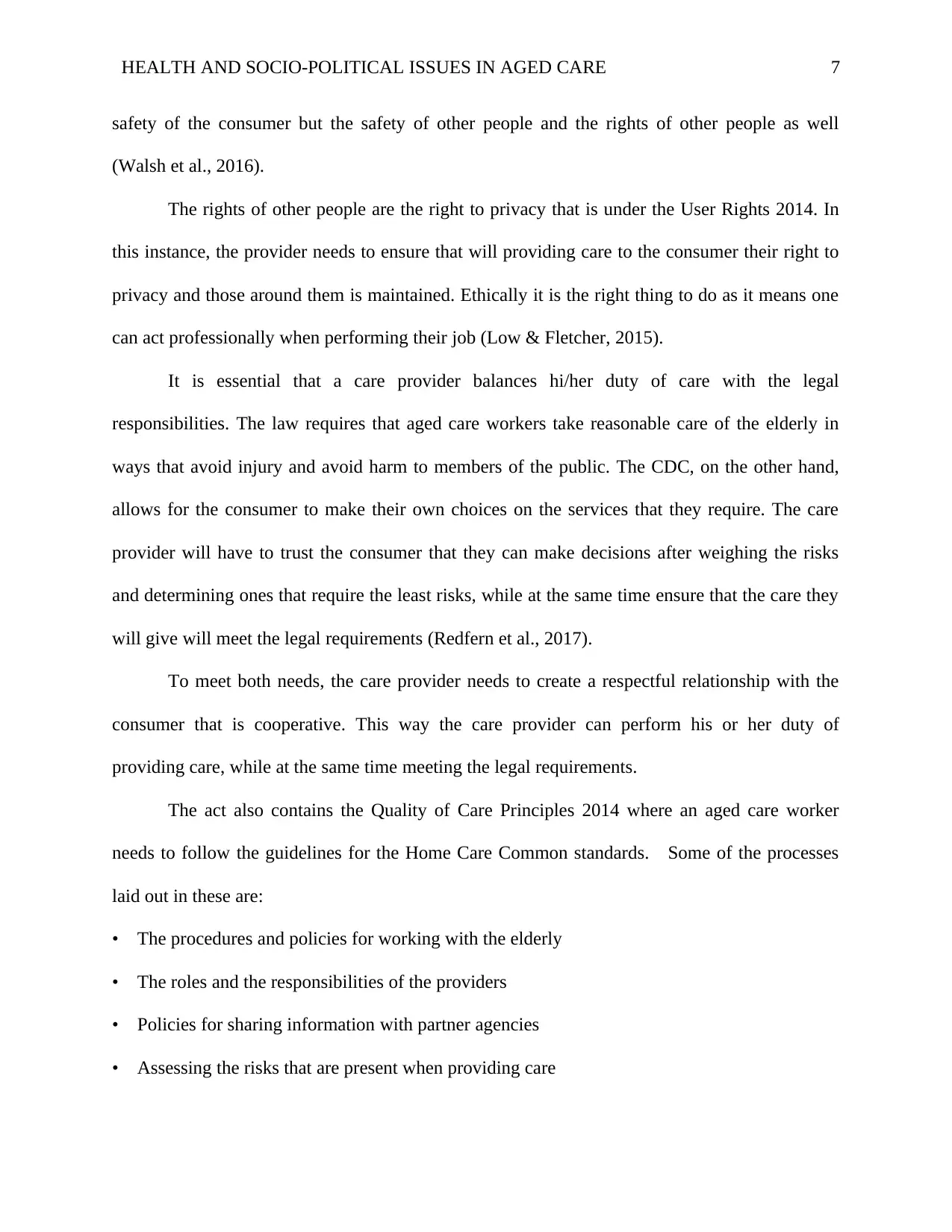
HEALTH AND SOCIO-POLITICAL ISSUES IN AGED CARE 7
safety of the consumer but the safety of other people and the rights of other people as well
(Walsh et al., 2016).
The rights of other people are the right to privacy that is under the User Rights 2014. In
this instance, the provider needs to ensure that will providing care to the consumer their right to
privacy and those around them is maintained. Ethically it is the right thing to do as it means one
can act professionally when performing their job (Low & Fletcher, 2015).
It is essential that a care provider balances hi/her duty of care with the legal
responsibilities. The law requires that aged care workers take reasonable care of the elderly in
ways that avoid injury and avoid harm to members of the public. The CDC, on the other hand,
allows for the consumer to make their own choices on the services that they require. The care
provider will have to trust the consumer that they can make decisions after weighing the risks
and determining ones that require the least risks, while at the same time ensure that the care they
will give will meet the legal requirements (Redfern et al., 2017).
To meet both needs, the care provider needs to create a respectful relationship with the
consumer that is cooperative. This way the care provider can perform his or her duty of
providing care, while at the same time meeting the legal requirements.
The act also contains the Quality of Care Principles 2014 where an aged care worker
needs to follow the guidelines for the Home Care Common standards. Some of the processes
laid out in these are:
• The procedures and policies for working with the elderly
• The roles and the responsibilities of the providers
• Policies for sharing information with partner agencies
• Assessing the risks that are present when providing care
safety of the consumer but the safety of other people and the rights of other people as well
(Walsh et al., 2016).
The rights of other people are the right to privacy that is under the User Rights 2014. In
this instance, the provider needs to ensure that will providing care to the consumer their right to
privacy and those around them is maintained. Ethically it is the right thing to do as it means one
can act professionally when performing their job (Low & Fletcher, 2015).
It is essential that a care provider balances hi/her duty of care with the legal
responsibilities. The law requires that aged care workers take reasonable care of the elderly in
ways that avoid injury and avoid harm to members of the public. The CDC, on the other hand,
allows for the consumer to make their own choices on the services that they require. The care
provider will have to trust the consumer that they can make decisions after weighing the risks
and determining ones that require the least risks, while at the same time ensure that the care they
will give will meet the legal requirements (Redfern et al., 2017).
To meet both needs, the care provider needs to create a respectful relationship with the
consumer that is cooperative. This way the care provider can perform his or her duty of
providing care, while at the same time meeting the legal requirements.
The act also contains the Quality of Care Principles 2014 where an aged care worker
needs to follow the guidelines for the Home Care Common standards. Some of the processes
laid out in these are:
• The procedures and policies for working with the elderly
• The roles and the responsibilities of the providers
• Policies for sharing information with partner agencies
• Assessing the risks that are present when providing care
Paraphrase This Document
Need a fresh take? Get an instant paraphrase of this document with our AI Paraphraser
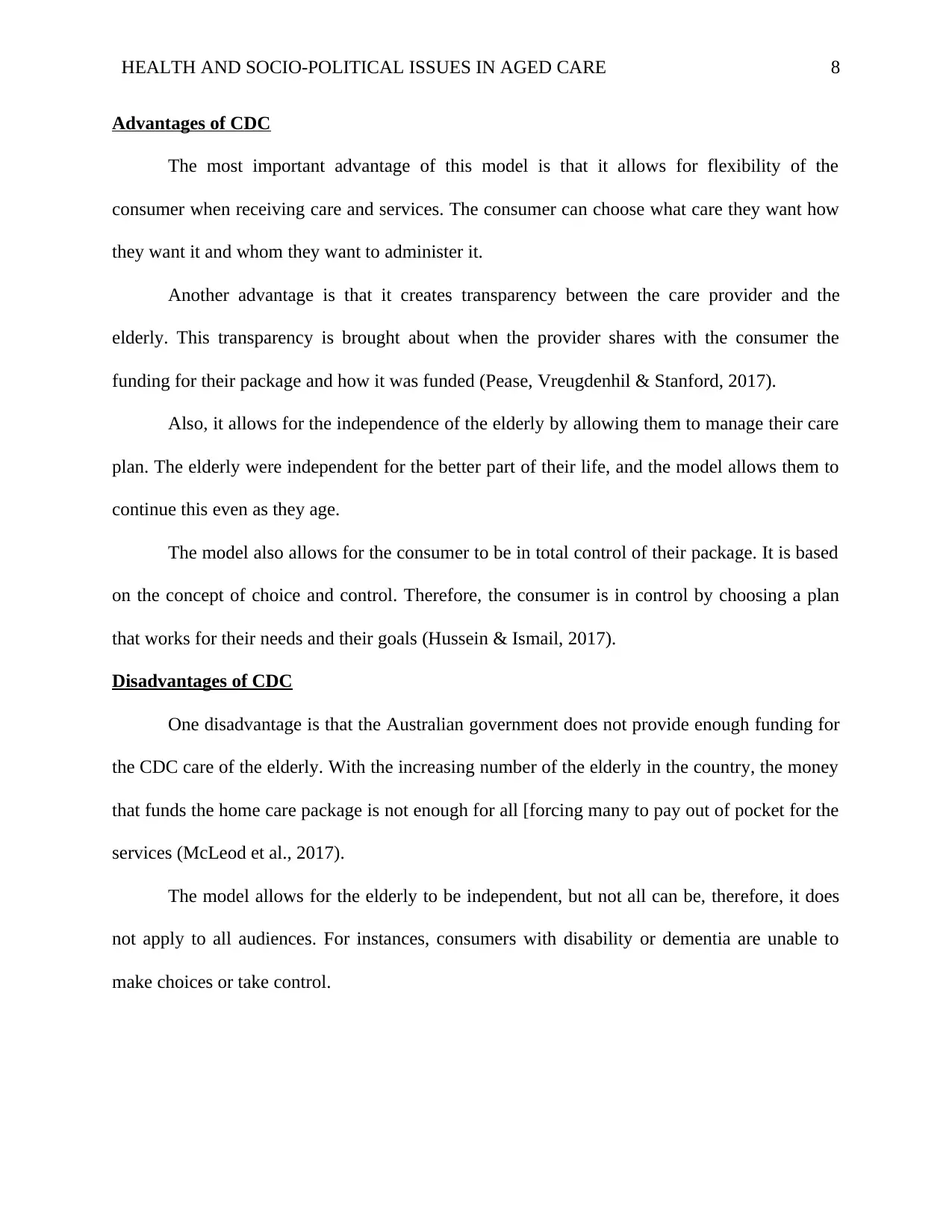
HEALTH AND SOCIO-POLITICAL ISSUES IN AGED CARE 8
Advantages of CDC
The most important advantage of this model is that it allows for flexibility of the
consumer when receiving care and services. The consumer can choose what care they want how
they want it and whom they want to administer it.
Another advantage is that it creates transparency between the care provider and the
elderly. This transparency is brought about when the provider shares with the consumer the
funding for their package and how it was funded (Pease, Vreugdenhil & Stanford, 2017).
Also, it allows for the independence of the elderly by allowing them to manage their care
plan. The elderly were independent for the better part of their life, and the model allows them to
continue this even as they age.
The model also allows for the consumer to be in total control of their package. It is based
on the concept of choice and control. Therefore, the consumer is in control by choosing a plan
that works for their needs and their goals (Hussein & Ismail, 2017).
Disadvantages of CDC
One disadvantage is that the Australian government does not provide enough funding for
the CDC care of the elderly. With the increasing number of the elderly in the country, the money
that funds the home care package is not enough for all [forcing many to pay out of pocket for the
services (McLeod et al., 2017).
The model allows for the elderly to be independent, but not all can be, therefore, it does
not apply to all audiences. For instances, consumers with disability or dementia are unable to
make choices or take control.
Advantages of CDC
The most important advantage of this model is that it allows for flexibility of the
consumer when receiving care and services. The consumer can choose what care they want how
they want it and whom they want to administer it.
Another advantage is that it creates transparency between the care provider and the
elderly. This transparency is brought about when the provider shares with the consumer the
funding for their package and how it was funded (Pease, Vreugdenhil & Stanford, 2017).
Also, it allows for the independence of the elderly by allowing them to manage their care
plan. The elderly were independent for the better part of their life, and the model allows them to
continue this even as they age.
The model also allows for the consumer to be in total control of their package. It is based
on the concept of choice and control. Therefore, the consumer is in control by choosing a plan
that works for their needs and their goals (Hussein & Ismail, 2017).
Disadvantages of CDC
One disadvantage is that the Australian government does not provide enough funding for
the CDC care of the elderly. With the increasing number of the elderly in the country, the money
that funds the home care package is not enough for all [forcing many to pay out of pocket for the
services (McLeod et al., 2017).
The model allows for the elderly to be independent, but not all can be, therefore, it does
not apply to all audiences. For instances, consumers with disability or dementia are unable to
make choices or take control.
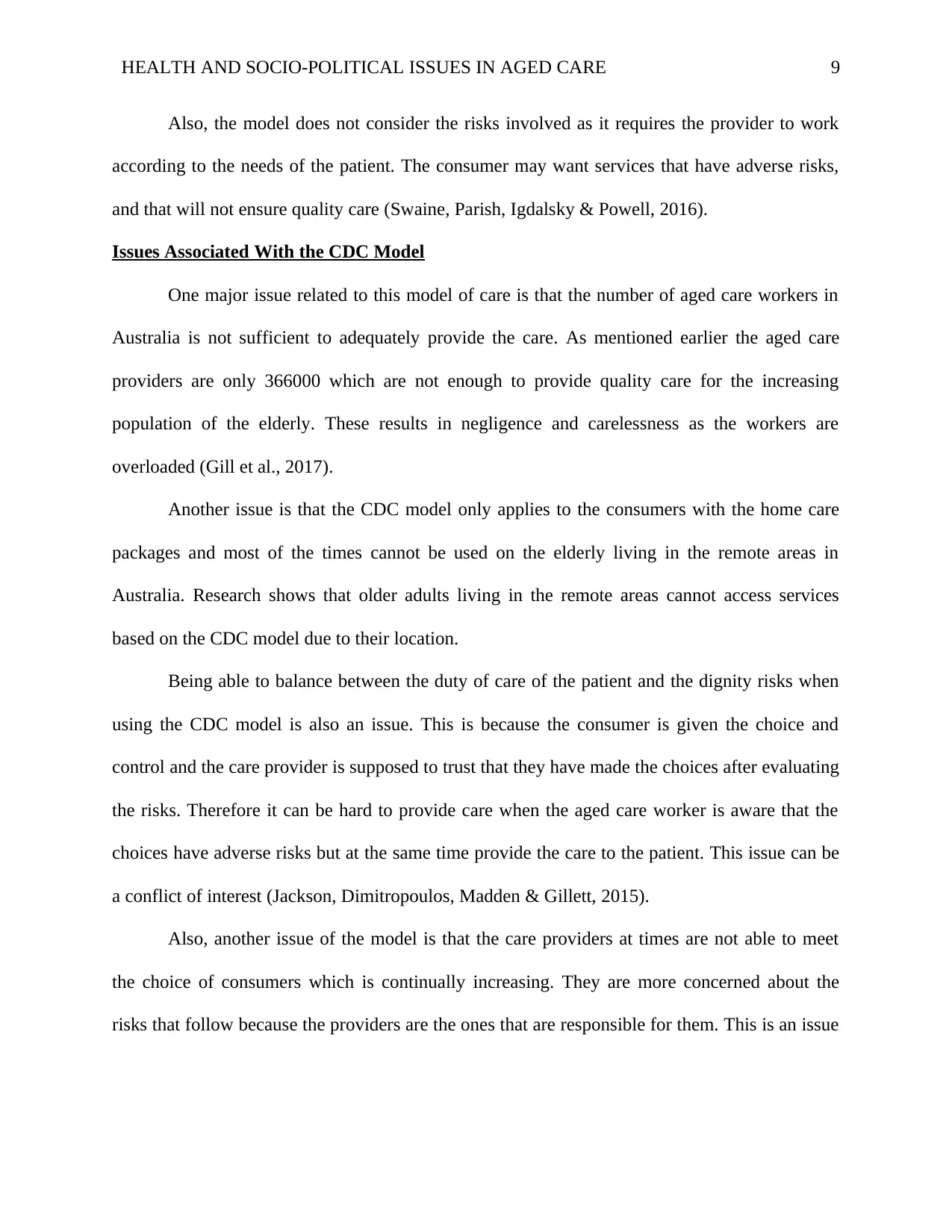
HEALTH AND SOCIO-POLITICAL ISSUES IN AGED CARE 9
Also, the model does not consider the risks involved as it requires the provider to work
according to the needs of the patient. The consumer may want services that have adverse risks,
and that will not ensure quality care (Swaine, Parish, Igdalsky & Powell, 2016).
Issues Associated With the CDC Model
One major issue related to this model of care is that the number of aged care workers in
Australia is not sufficient to adequately provide the care. As mentioned earlier the aged care
providers are only 366000 which are not enough to provide quality care for the increasing
population of the elderly. These results in negligence and carelessness as the workers are
overloaded (Gill et al., 2017).
Another issue is that the CDC model only applies to the consumers with the home care
packages and most of the times cannot be used on the elderly living in the remote areas in
Australia. Research shows that older adults living in the remote areas cannot access services
based on the CDC model due to their location.
Being able to balance between the duty of care of the patient and the dignity risks when
using the CDC model is also an issue. This is because the consumer is given the choice and
control and the care provider is supposed to trust that they have made the choices after evaluating
the risks. Therefore it can be hard to provide care when the aged care worker is aware that the
choices have adverse risks but at the same time provide the care to the patient. This issue can be
a conflict of interest (Jackson, Dimitropoulos, Madden & Gillett, 2015).
Also, another issue of the model is that the care providers at times are not able to meet
the choice of consumers which is continually increasing. They are more concerned about the
risks that follow because the providers are the ones that are responsible for them. This is an issue
Also, the model does not consider the risks involved as it requires the provider to work
according to the needs of the patient. The consumer may want services that have adverse risks,
and that will not ensure quality care (Swaine, Parish, Igdalsky & Powell, 2016).
Issues Associated With the CDC Model
One major issue related to this model of care is that the number of aged care workers in
Australia is not sufficient to adequately provide the care. As mentioned earlier the aged care
providers are only 366000 which are not enough to provide quality care for the increasing
population of the elderly. These results in negligence and carelessness as the workers are
overloaded (Gill et al., 2017).
Another issue is that the CDC model only applies to the consumers with the home care
packages and most of the times cannot be used on the elderly living in the remote areas in
Australia. Research shows that older adults living in the remote areas cannot access services
based on the CDC model due to their location.
Being able to balance between the duty of care of the patient and the dignity risks when
using the CDC model is also an issue. This is because the consumer is given the choice and
control and the care provider is supposed to trust that they have made the choices after evaluating
the risks. Therefore it can be hard to provide care when the aged care worker is aware that the
choices have adverse risks but at the same time provide the care to the patient. This issue can be
a conflict of interest (Jackson, Dimitropoulos, Madden & Gillett, 2015).
Also, another issue of the model is that the care providers at times are not able to meet
the choice of consumers which is continually increasing. They are more concerned about the
risks that follow because the providers are the ones that are responsible for them. This is an issue
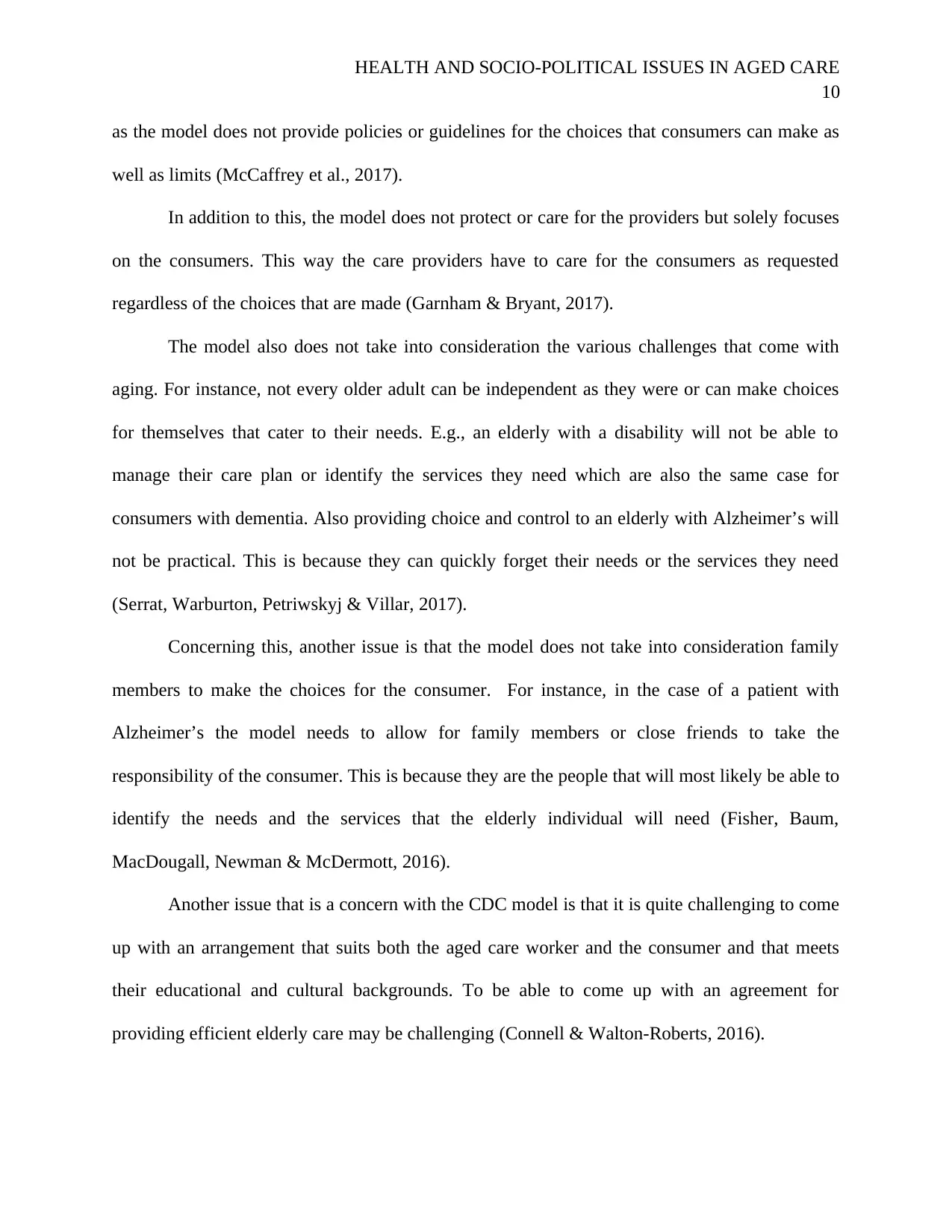
HEALTH AND SOCIO-POLITICAL ISSUES IN AGED CARE
10
as the model does not provide policies or guidelines for the choices that consumers can make as
well as limits (McCaffrey et al., 2017).
In addition to this, the model does not protect or care for the providers but solely focuses
on the consumers. This way the care providers have to care for the consumers as requested
regardless of the choices that are made (Garnham & Bryant, 2017).
The model also does not take into consideration the various challenges that come with
aging. For instance, not every older adult can be independent as they were or can make choices
for themselves that cater to their needs. E.g., an elderly with a disability will not be able to
manage their care plan or identify the services they need which are also the same case for
consumers with dementia. Also providing choice and control to an elderly with Alzheimer’s will
not be practical. This is because they can quickly forget their needs or the services they need
(Serrat, Warburton, Petriwskyj & Villar, 2017).
Concerning this, another issue is that the model does not take into consideration family
members to make the choices for the consumer. For instance, in the case of a patient with
Alzheimer’s the model needs to allow for family members or close friends to take the
responsibility of the consumer. This is because they are the people that will most likely be able to
identify the needs and the services that the elderly individual will need (Fisher, Baum,
MacDougall, Newman & McDermott, 2016).
Another issue that is a concern with the CDC model is that it is quite challenging to come
up with an arrangement that suits both the aged care worker and the consumer and that meets
their educational and cultural backgrounds. To be able to come up with an agreement for
providing efficient elderly care may be challenging (Connell & Walton-Roberts, 2016).
10
as the model does not provide policies or guidelines for the choices that consumers can make as
well as limits (McCaffrey et al., 2017).
In addition to this, the model does not protect or care for the providers but solely focuses
on the consumers. This way the care providers have to care for the consumers as requested
regardless of the choices that are made (Garnham & Bryant, 2017).
The model also does not take into consideration the various challenges that come with
aging. For instance, not every older adult can be independent as they were or can make choices
for themselves that cater to their needs. E.g., an elderly with a disability will not be able to
manage their care plan or identify the services they need which are also the same case for
consumers with dementia. Also providing choice and control to an elderly with Alzheimer’s will
not be practical. This is because they can quickly forget their needs or the services they need
(Serrat, Warburton, Petriwskyj & Villar, 2017).
Concerning this, another issue is that the model does not take into consideration family
members to make the choices for the consumer. For instance, in the case of a patient with
Alzheimer’s the model needs to allow for family members or close friends to take the
responsibility of the consumer. This is because they are the people that will most likely be able to
identify the needs and the services that the elderly individual will need (Fisher, Baum,
MacDougall, Newman & McDermott, 2016).
Another issue that is a concern with the CDC model is that it is quite challenging to come
up with an arrangement that suits both the aged care worker and the consumer and that meets
their educational and cultural backgrounds. To be able to come up with an agreement for
providing efficient elderly care may be challenging (Connell & Walton-Roberts, 2016).
Secure Best Marks with AI Grader
Need help grading? Try our AI Grader for instant feedback on your assignments.
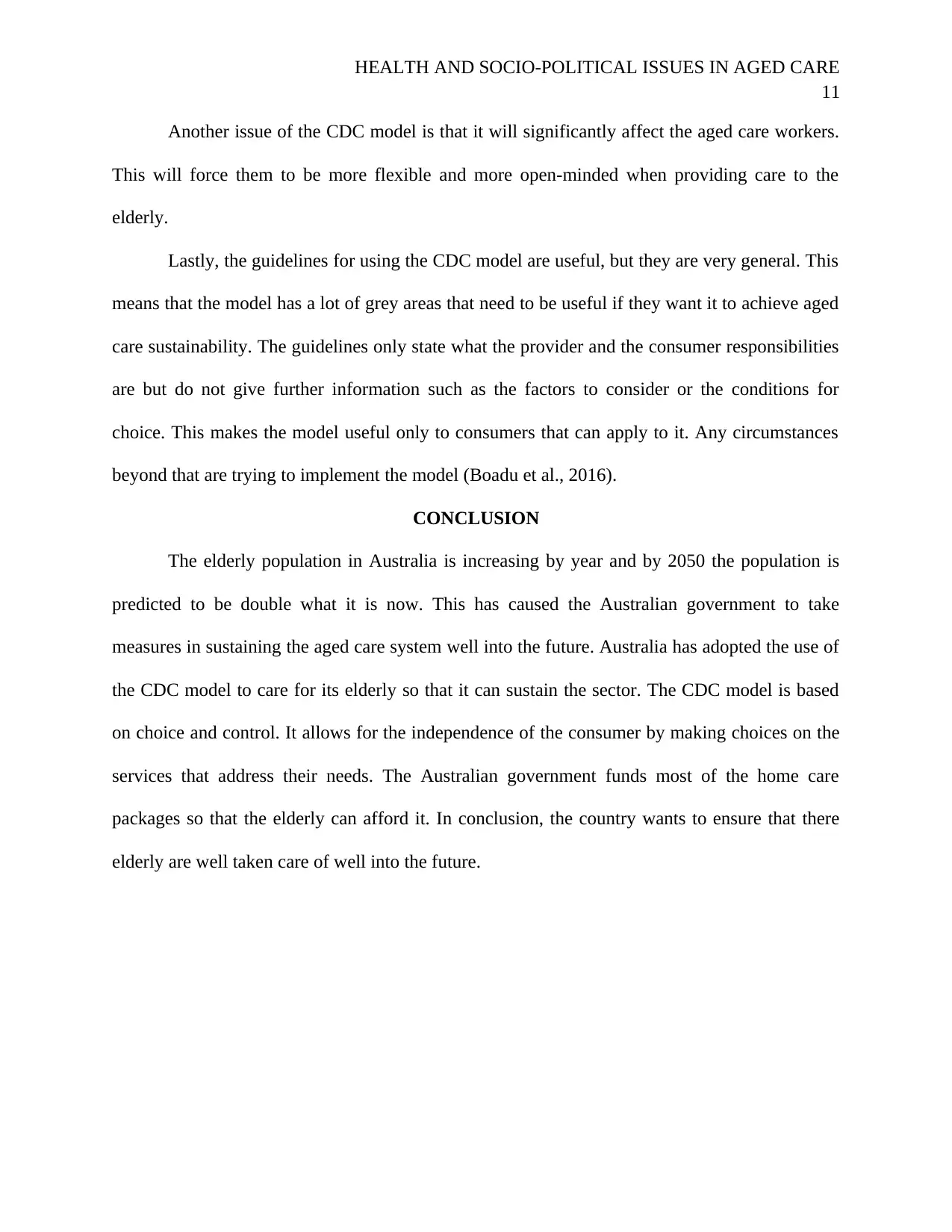
HEALTH AND SOCIO-POLITICAL ISSUES IN AGED CARE
11
Another issue of the CDC model is that it will significantly affect the aged care workers.
This will force them to be more flexible and more open-minded when providing care to the
elderly.
Lastly, the guidelines for using the CDC model are useful, but they are very general. This
means that the model has a lot of grey areas that need to be useful if they want it to achieve aged
care sustainability. The guidelines only state what the provider and the consumer responsibilities
are but do not give further information such as the factors to consider or the conditions for
choice. This makes the model useful only to consumers that can apply to it. Any circumstances
beyond that are trying to implement the model (Boadu et al., 2016).
CONCLUSION
The elderly population in Australia is increasing by year and by 2050 the population is
predicted to be double what it is now. This has caused the Australian government to take
measures in sustaining the aged care system well into the future. Australia has adopted the use of
the CDC model to care for its elderly so that it can sustain the sector. The CDC model is based
on choice and control. It allows for the independence of the consumer by making choices on the
services that address their needs. The Australian government funds most of the home care
packages so that the elderly can afford it. In conclusion, the country wants to ensure that there
elderly are well taken care of well into the future.
11
Another issue of the CDC model is that it will significantly affect the aged care workers.
This will force them to be more flexible and more open-minded when providing care to the
elderly.
Lastly, the guidelines for using the CDC model are useful, but they are very general. This
means that the model has a lot of grey areas that need to be useful if they want it to achieve aged
care sustainability. The guidelines only state what the provider and the consumer responsibilities
are but do not give further information such as the factors to consider or the conditions for
choice. This makes the model useful only to consumers that can apply to it. Any circumstances
beyond that are trying to implement the model (Boadu et al., 2016).
CONCLUSION
The elderly population in Australia is increasing by year and by 2050 the population is
predicted to be double what it is now. This has caused the Australian government to take
measures in sustaining the aged care system well into the future. Australia has adopted the use of
the CDC model to care for its elderly so that it can sustain the sector. The CDC model is based
on choice and control. It allows for the independence of the consumer by making choices on the
services that address their needs. The Australian government funds most of the home care
packages so that the elderly can afford it. In conclusion, the country wants to ensure that there
elderly are well taken care of well into the future.
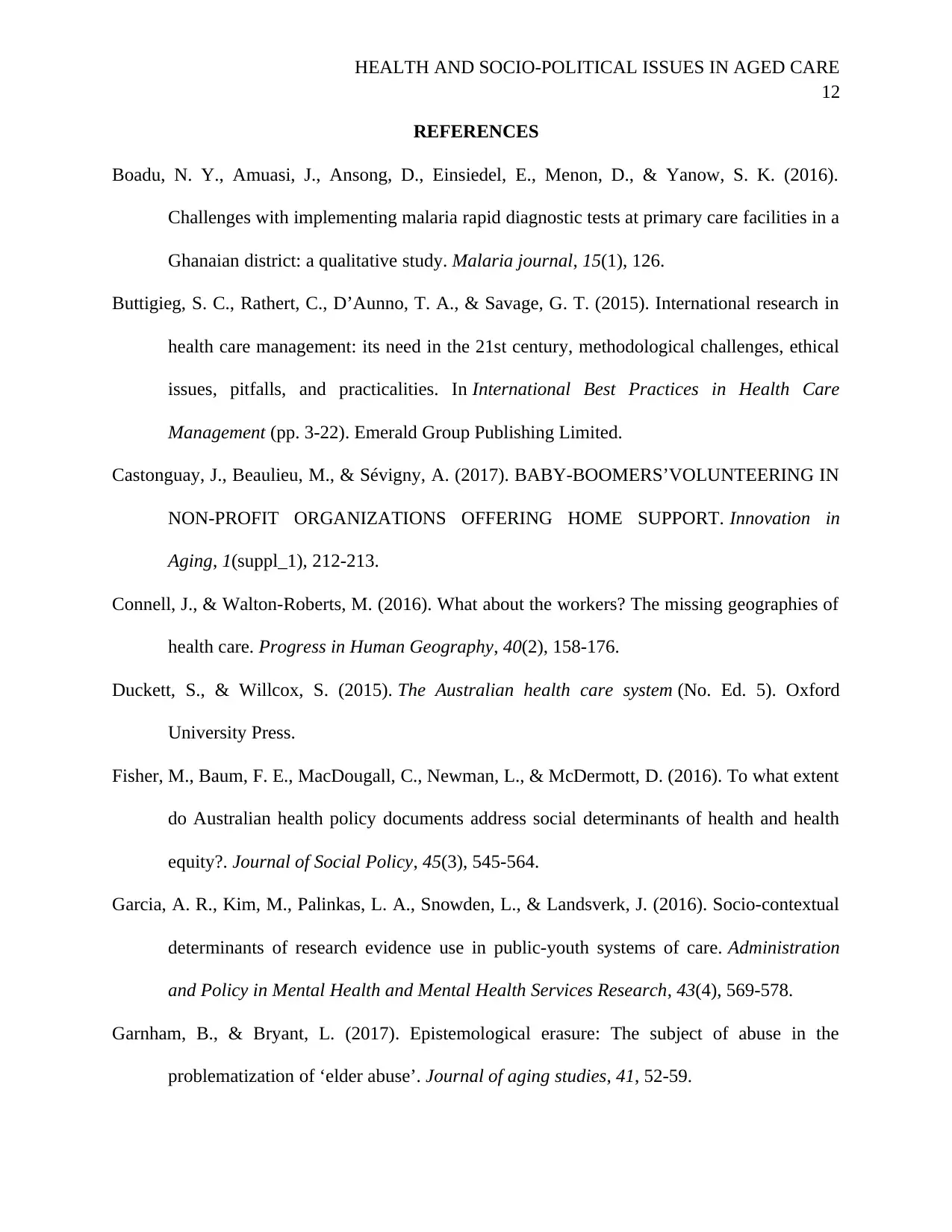
HEALTH AND SOCIO-POLITICAL ISSUES IN AGED CARE
12
REFERENCES
Boadu, N. Y., Amuasi, J., Ansong, D., Einsiedel, E., Menon, D., & Yanow, S. K. (2016).
Challenges with implementing malaria rapid diagnostic tests at primary care facilities in a
Ghanaian district: a qualitative study. Malaria journal, 15(1), 126.
Buttigieg, S. C., Rathert, C., D’Aunno, T. A., & Savage, G. T. (2015). International research in
health care management: its need in the 21st century, methodological challenges, ethical
issues, pitfalls, and practicalities. In International Best Practices in Health Care
Management (pp. 3-22). Emerald Group Publishing Limited.
Castonguay, J., Beaulieu, M., & Sévigny, A. (2017). BABY-BOOMERS’VOLUNTEERING IN
NON-PROFIT ORGANIZATIONS OFFERING HOME SUPPORT. Innovation in
Aging, 1(suppl_1), 212-213.
Connell, J., & Walton-Roberts, M. (2016). What about the workers? The missing geographies of
health care. Progress in Human Geography, 40(2), 158-176.
Duckett, S., & Willcox, S. (2015). The Australian health care system (No. Ed. 5). Oxford
University Press.
Fisher, M., Baum, F. E., MacDougall, C., Newman, L., & McDermott, D. (2016). To what extent
do Australian health policy documents address social determinants of health and health
equity?. Journal of Social Policy, 45(3), 545-564.
Garcia, A. R., Kim, M., Palinkas, L. A., Snowden, L., & Landsverk, J. (2016). Socio-contextual
determinants of research evidence use in public-youth systems of care. Administration
and Policy in Mental Health and Mental Health Services Research, 43(4), 569-578.
Garnham, B., & Bryant, L. (2017). Epistemological erasure: The subject of abuse in the
problematization of ‘elder abuse’. Journal of aging studies, 41, 52-59.
12
REFERENCES
Boadu, N. Y., Amuasi, J., Ansong, D., Einsiedel, E., Menon, D., & Yanow, S. K. (2016).
Challenges with implementing malaria rapid diagnostic tests at primary care facilities in a
Ghanaian district: a qualitative study. Malaria journal, 15(1), 126.
Buttigieg, S. C., Rathert, C., D’Aunno, T. A., & Savage, G. T. (2015). International research in
health care management: its need in the 21st century, methodological challenges, ethical
issues, pitfalls, and practicalities. In International Best Practices in Health Care
Management (pp. 3-22). Emerald Group Publishing Limited.
Castonguay, J., Beaulieu, M., & Sévigny, A. (2017). BABY-BOOMERS’VOLUNTEERING IN
NON-PROFIT ORGANIZATIONS OFFERING HOME SUPPORT. Innovation in
Aging, 1(suppl_1), 212-213.
Connell, J., & Walton-Roberts, M. (2016). What about the workers? The missing geographies of
health care. Progress in Human Geography, 40(2), 158-176.
Duckett, S., & Willcox, S. (2015). The Australian health care system (No. Ed. 5). Oxford
University Press.
Fisher, M., Baum, F. E., MacDougall, C., Newman, L., & McDermott, D. (2016). To what extent
do Australian health policy documents address social determinants of health and health
equity?. Journal of Social Policy, 45(3), 545-564.
Garcia, A. R., Kim, M., Palinkas, L. A., Snowden, L., & Landsverk, J. (2016). Socio-contextual
determinants of research evidence use in public-youth systems of care. Administration
and Policy in Mental Health and Mental Health Services Research, 43(4), 569-578.
Garnham, B., & Bryant, L. (2017). Epistemological erasure: The subject of abuse in the
problematization of ‘elder abuse’. Journal of aging studies, 41, 52-59.
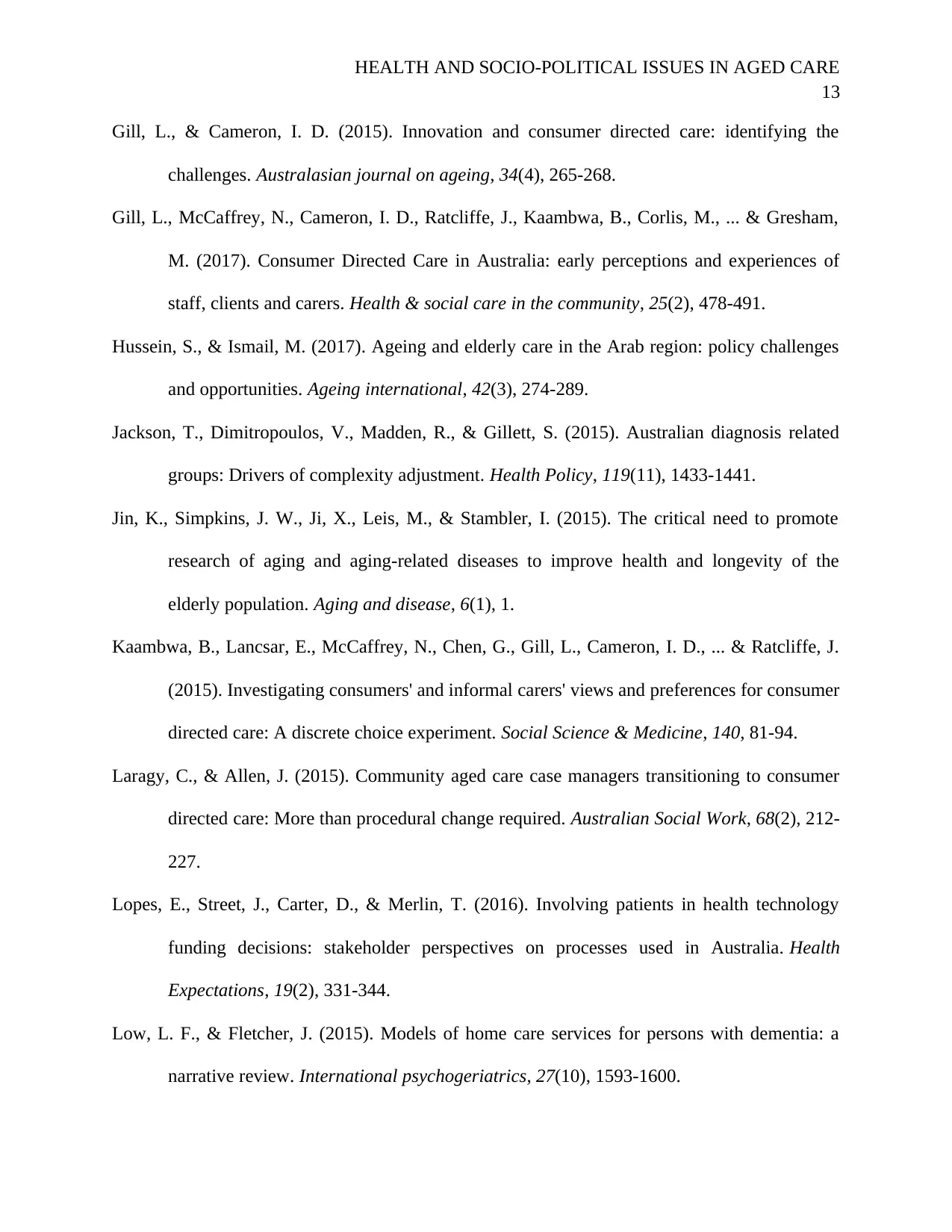
HEALTH AND SOCIO-POLITICAL ISSUES IN AGED CARE
13
Gill, L., & Cameron, I. D. (2015). Innovation and consumer directed care: identifying the
challenges. Australasian journal on ageing, 34(4), 265-268.
Gill, L., McCaffrey, N., Cameron, I. D., Ratcliffe, J., Kaambwa, B., Corlis, M., ... & Gresham,
M. (2017). Consumer Directed Care in Australia: early perceptions and experiences of
staff, clients and carers. Health & social care in the community, 25(2), 478-491.
Hussein, S., & Ismail, M. (2017). Ageing and elderly care in the Arab region: policy challenges
and opportunities. Ageing international, 42(3), 274-289.
Jackson, T., Dimitropoulos, V., Madden, R., & Gillett, S. (2015). Australian diagnosis related
groups: Drivers of complexity adjustment. Health Policy, 119(11), 1433-1441.
Jin, K., Simpkins, J. W., Ji, X., Leis, M., & Stambler, I. (2015). The critical need to promote
research of aging and aging-related diseases to improve health and longevity of the
elderly population. Aging and disease, 6(1), 1.
Kaambwa, B., Lancsar, E., McCaffrey, N., Chen, G., Gill, L., Cameron, I. D., ... & Ratcliffe, J.
(2015). Investigating consumers' and informal carers' views and preferences for consumer
directed care: A discrete choice experiment. Social Science & Medicine, 140, 81-94.
Laragy, C., & Allen, J. (2015). Community aged care case managers transitioning to consumer
directed care: More than procedural change required. Australian Social Work, 68(2), 212-
227.
Lopes, E., Street, J., Carter, D., & Merlin, T. (2016). Involving patients in health technology
funding decisions: stakeholder perspectives on processes used in Australia. Health
Expectations, 19(2), 331-344.
Low, L. F., & Fletcher, J. (2015). Models of home care services for persons with dementia: a
narrative review. International psychogeriatrics, 27(10), 1593-1600.
13
Gill, L., & Cameron, I. D. (2015). Innovation and consumer directed care: identifying the
challenges. Australasian journal on ageing, 34(4), 265-268.
Gill, L., McCaffrey, N., Cameron, I. D., Ratcliffe, J., Kaambwa, B., Corlis, M., ... & Gresham,
M. (2017). Consumer Directed Care in Australia: early perceptions and experiences of
staff, clients and carers. Health & social care in the community, 25(2), 478-491.
Hussein, S., & Ismail, M. (2017). Ageing and elderly care in the Arab region: policy challenges
and opportunities. Ageing international, 42(3), 274-289.
Jackson, T., Dimitropoulos, V., Madden, R., & Gillett, S. (2015). Australian diagnosis related
groups: Drivers of complexity adjustment. Health Policy, 119(11), 1433-1441.
Jin, K., Simpkins, J. W., Ji, X., Leis, M., & Stambler, I. (2015). The critical need to promote
research of aging and aging-related diseases to improve health and longevity of the
elderly population. Aging and disease, 6(1), 1.
Kaambwa, B., Lancsar, E., McCaffrey, N., Chen, G., Gill, L., Cameron, I. D., ... & Ratcliffe, J.
(2015). Investigating consumers' and informal carers' views and preferences for consumer
directed care: A discrete choice experiment. Social Science & Medicine, 140, 81-94.
Laragy, C., & Allen, J. (2015). Community aged care case managers transitioning to consumer
directed care: More than procedural change required. Australian Social Work, 68(2), 212-
227.
Lopes, E., Street, J., Carter, D., & Merlin, T. (2016). Involving patients in health technology
funding decisions: stakeholder perspectives on processes used in Australia. Health
Expectations, 19(2), 331-344.
Low, L. F., & Fletcher, J. (2015). Models of home care services for persons with dementia: a
narrative review. International psychogeriatrics, 27(10), 1593-1600.
Paraphrase This Document
Need a fresh take? Get an instant paraphrase of this document with our AI Paraphraser
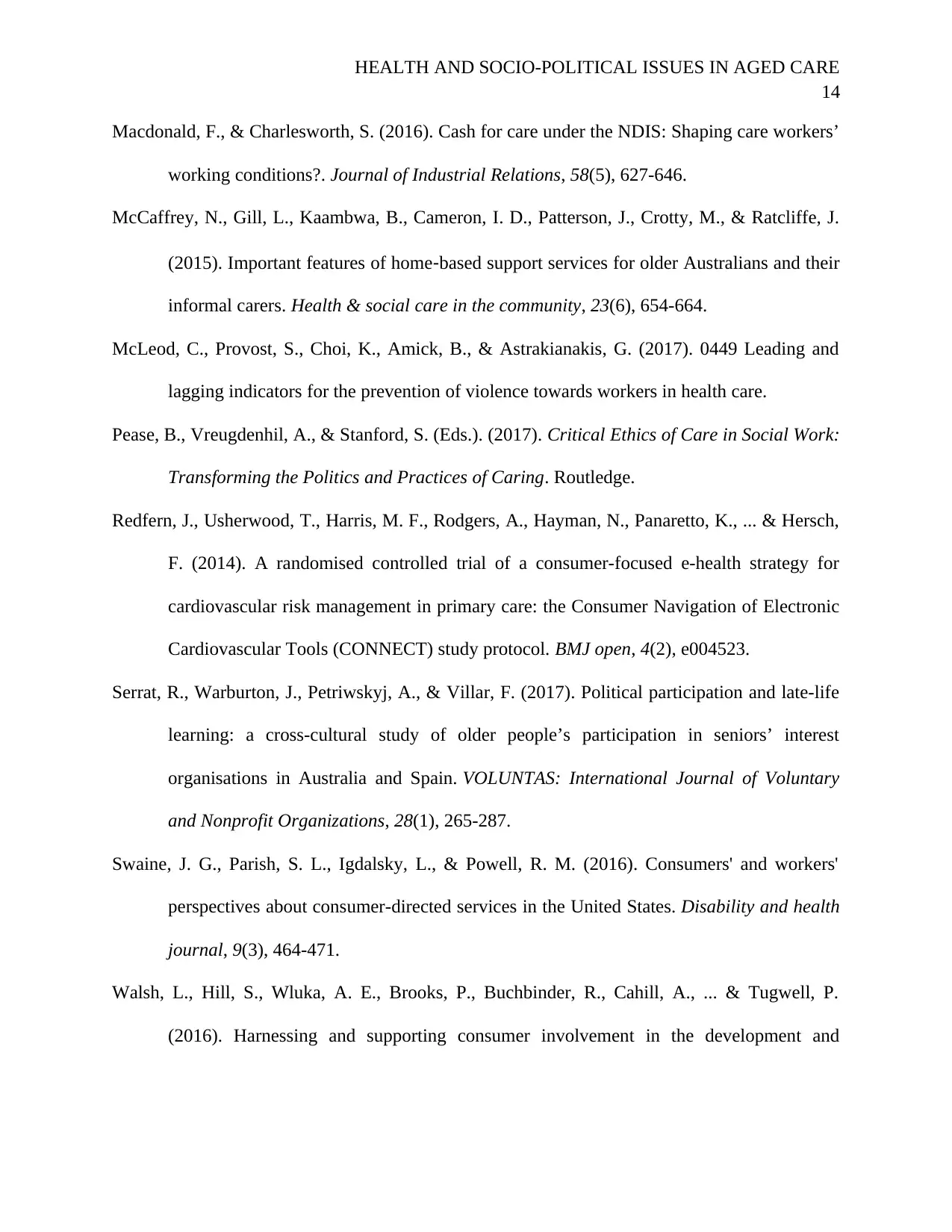
HEALTH AND SOCIO-POLITICAL ISSUES IN AGED CARE
14
Macdonald, F., & Charlesworth, S. (2016). Cash for care under the NDIS: Shaping care workers’
working conditions?. Journal of Industrial Relations, 58(5), 627-646.
McCaffrey, N., Gill, L., Kaambwa, B., Cameron, I. D., Patterson, J., Crotty, M., & Ratcliffe, J.
(2015). Important features of home‐based support services for older Australians and their
informal carers. Health & social care in the community, 23(6), 654-664.
McLeod, C., Provost, S., Choi, K., Amick, B., & Astrakianakis, G. (2017). 0449 Leading and
lagging indicators for the prevention of violence towards workers in health care.
Pease, B., Vreugdenhil, A., & Stanford, S. (Eds.). (2017). Critical Ethics of Care in Social Work:
Transforming the Politics and Practices of Caring. Routledge.
Redfern, J., Usherwood, T., Harris, M. F., Rodgers, A., Hayman, N., Panaretto, K., ... & Hersch,
F. (2014). A randomised controlled trial of a consumer-focused e-health strategy for
cardiovascular risk management in primary care: the Consumer Navigation of Electronic
Cardiovascular Tools (CONNECT) study protocol. BMJ open, 4(2), e004523.
Serrat, R., Warburton, J., Petriwskyj, A., & Villar, F. (2017). Political participation and late-life
learning: a cross-cultural study of older people’s participation in seniors’ interest
organisations in Australia and Spain. VOLUNTAS: International Journal of Voluntary
and Nonprofit Organizations, 28(1), 265-287.
Swaine, J. G., Parish, S. L., Igdalsky, L., & Powell, R. M. (2016). Consumers' and workers'
perspectives about consumer-directed services in the United States. Disability and health
journal, 9(3), 464-471.
Walsh, L., Hill, S., Wluka, A. E., Brooks, P., Buchbinder, R., Cahill, A., ... & Tugwell, P.
(2016). Harnessing and supporting consumer involvement in the development and
14
Macdonald, F., & Charlesworth, S. (2016). Cash for care under the NDIS: Shaping care workers’
working conditions?. Journal of Industrial Relations, 58(5), 627-646.
McCaffrey, N., Gill, L., Kaambwa, B., Cameron, I. D., Patterson, J., Crotty, M., & Ratcliffe, J.
(2015). Important features of home‐based support services for older Australians and their
informal carers. Health & social care in the community, 23(6), 654-664.
McLeod, C., Provost, S., Choi, K., Amick, B., & Astrakianakis, G. (2017). 0449 Leading and
lagging indicators for the prevention of violence towards workers in health care.
Pease, B., Vreugdenhil, A., & Stanford, S. (Eds.). (2017). Critical Ethics of Care in Social Work:
Transforming the Politics and Practices of Caring. Routledge.
Redfern, J., Usherwood, T., Harris, M. F., Rodgers, A., Hayman, N., Panaretto, K., ... & Hersch,
F. (2014). A randomised controlled trial of a consumer-focused e-health strategy for
cardiovascular risk management in primary care: the Consumer Navigation of Electronic
Cardiovascular Tools (CONNECT) study protocol. BMJ open, 4(2), e004523.
Serrat, R., Warburton, J., Petriwskyj, A., & Villar, F. (2017). Political participation and late-life
learning: a cross-cultural study of older people’s participation in seniors’ interest
organisations in Australia and Spain. VOLUNTAS: International Journal of Voluntary
and Nonprofit Organizations, 28(1), 265-287.
Swaine, J. G., Parish, S. L., Igdalsky, L., & Powell, R. M. (2016). Consumers' and workers'
perspectives about consumer-directed services in the United States. Disability and health
journal, 9(3), 464-471.
Walsh, L., Hill, S., Wluka, A. E., Brooks, P., Buchbinder, R., Cahill, A., ... & Tugwell, P.
(2016). Harnessing and supporting consumer involvement in the development and
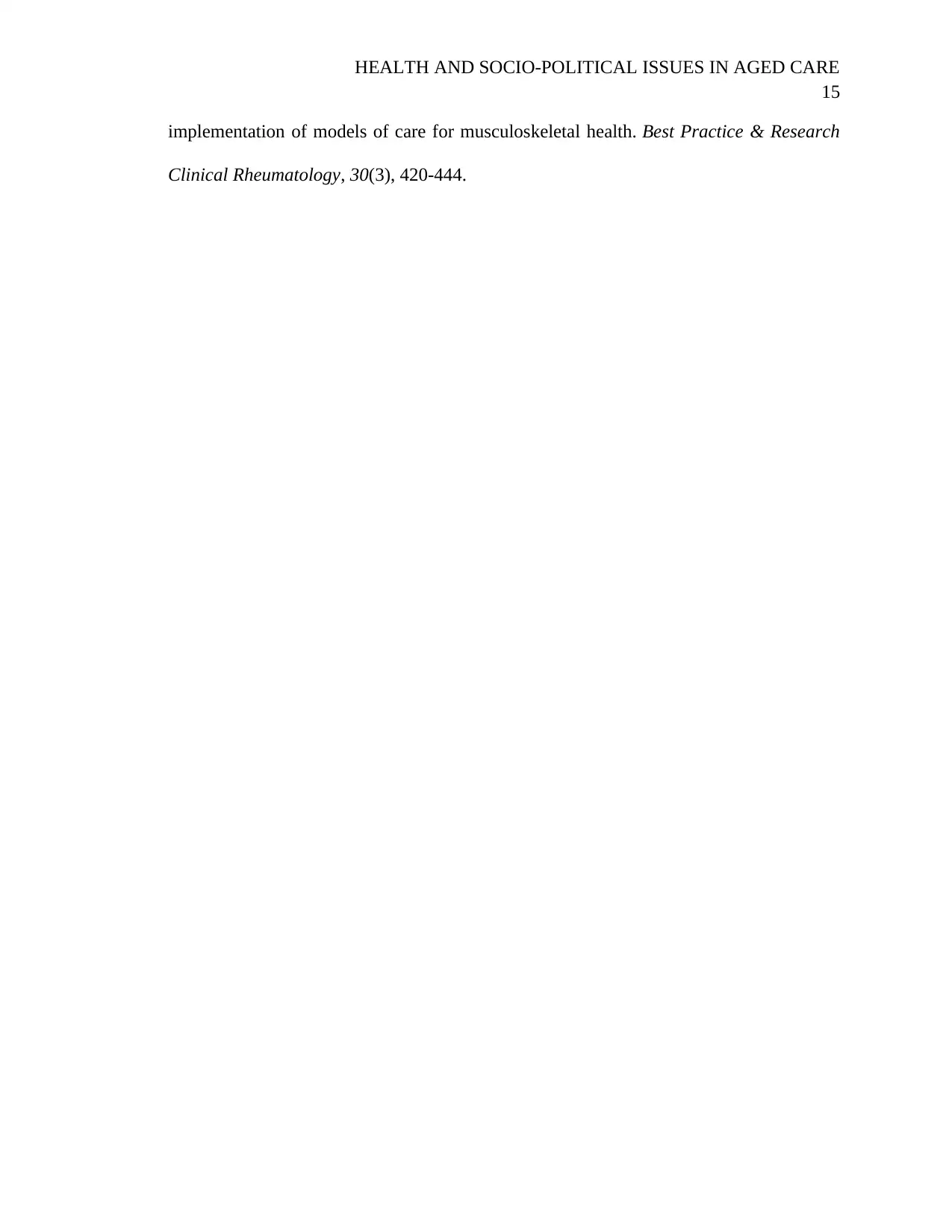
HEALTH AND SOCIO-POLITICAL ISSUES IN AGED CARE
15
implementation of models of care for musculoskeletal health. Best Practice & Research
Clinical Rheumatology, 30(3), 420-444.
15
implementation of models of care for musculoskeletal health. Best Practice & Research
Clinical Rheumatology, 30(3), 420-444.
1 out of 15
Related Documents
Your All-in-One AI-Powered Toolkit for Academic Success.
+13062052269
info@desklib.com
Available 24*7 on WhatsApp / Email
![[object Object]](/_next/static/media/star-bottom.7253800d.svg)
Unlock your academic potential
© 2024 | Zucol Services PVT LTD | All rights reserved.


